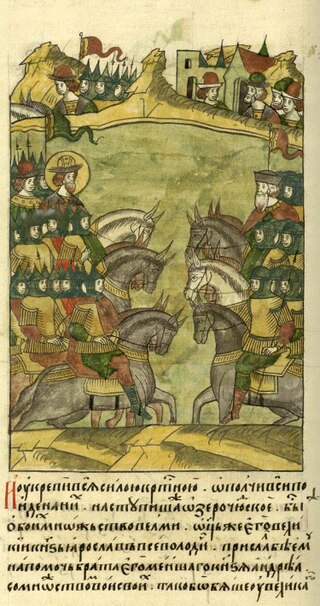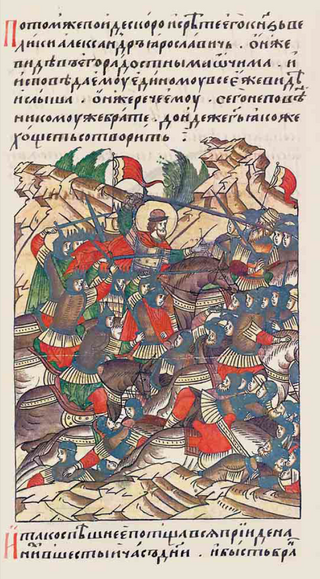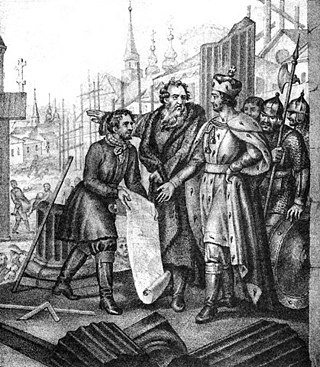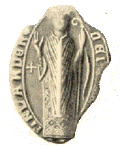
The Northern Crusades or Baltic Crusades were Christianization campaigns undertaken by Catholic Christian military orders and kingdoms, primarily against the pagan Baltic, Finnic and West Slavic peoples around the southern and eastern shores of the Baltic Sea, and also against Orthodox Christian East Slavs.

Pope Gregory IX was head of the Catholic Church and the ruler of the Papal States from 19 March 1227 until his death in 1241. He is known for issuing the Decretales and instituting the Papal Inquisition, in response to the failures of the episcopal inquisitions established during the time of Pope Lucius III, by means of the papal bull Ad abolendam, issued in 1184.
The Livonian Brothers of the Sword was a Catholic military order established in 1202 during the Livonian Crusade by Albert, the third bishop of Riga. Pope Innocent III sanctioned the establishment in 1204 for the second time. The membership of the crusading order comprised warrior monks, mostly from northern Germany, who fought Baltic and Finnic polytheists in the area of modern-day Estonia, Latvia and Lithuania. Alternative names of the Order include Christ Knights, Swordbrothers, Sword Brethren, Order of the Brothers of the Sword, and The Militia of Christ of Livonia. The seal reads: +MAGISTRI ETFRM MILICIE CRI (Christi) DE LIVONIA.

Eric XI the Lisp and Lame Swedish: Erik Eriksson or Erik läspe och halte; Old Norse: Eiríkr Eiríksson was King of Sweden in 1222–29 and 1234–50. Being the last ruler of the House of Eric, he stood in the shadow of a succession of powerful Jarls, especially his brother-in-law Birger Jarl, whose descendants ruled as kings after his death.

Henry was a medieval English clergyman. He came to Sweden with Cardinal Nicholas Breakspeare in 1153 and was most likely designated to be the new Archbishop of Uppsala, but the independent church province of Sweden could only be established in 1164 after the civil war, and Henry would have been sent to organize the Church in Finland, where Christians had already existed for two centuries.

The Battle of the Neva was fought between the Novgorod Republic, along with Karelians, and the Kingdom of Sweden, including Norwegian, Finnish and Tavastian forces, on the Neva River, near the settlement of Ust-Izhora, on 15 July 1240. The battle is mentioned only in Russian sources, and it remains unclear whether it was a major invasion or a small-scale raid. In Russian historiography, it has become an event of massive scale and importance.

Valerius was the Swedish Archbishop 1207–1219. He was the fifth archbishop after the establishment of the see in 1164.

The Second Swedish Crusade was a possible 13th-century Swedish military expedition against the Tavastians, in present-day Finland, led by Birger Jarl. Many details of the Crusade are debated. After the crusade, Tavastia gradually started to fall under the rule of the Catholic Church and the Swedish kingdom.
The Diocese of Åbo was the medieval, pre-Reformation Catholic predecessor of the later Archdiocese of Turku, a Evangelical Lutheran Church of Finland jurisdiction.
Fulco was the first known missionary Bishop of Estonia. He was appointed in 1165 by Eskil, the Danish Archbishop of Lund. Before his appointment, Fulco was a Benedictine monk in the abbey of Moutier-la-Celle, near Troyes in France. His nationality is not known.

Rodulff (Rodulf) is claimed by a 15th-century chronicle Chronicon episcoporum Finlandensium to have worked as a missionary "bishop" in Finland after Bishop Henry had died in the 1150s. Rodulff was allegedly from Västergötland in Sweden.

The Finnish–Novgorodian wars were a series of conflicts between Finnic tribes in eastern Fennoscandia and the Republic of Novgorod from the 11th or 12th century to the early 13th century.

Bero (Björn) was the first certainly Swedish Bishop of Finland in the mid-13th century. His historicity is not questioned.

The Tavastian uprising, also sometimes called the Häme uprising, was a uprising by Tavastians in Tavastia, Finland in the winter of 1236–1237. The rebellion was against the Kingdom of Sweden and against the Catholic Church. The Tavastian rebels received aid from the Novgorod Republic, which sought to diminish Swedish influence in Finland in order to bolster its own position.

The Stedinger Crusade (1233–1234) was a Papally sanctioned war against the rebellious peasants of Stedingen.

Philip of Tripoli, sometimes Philippus Tripolitanus or Philip of Foligno, was an Italian Catholic priest and translator. Although he had a markedly successful clerical career, his most enduring legacy is his translation of the complete Pseudo-Aristotelian Secretum secretorum from Arabic into Latin around 1230.

Thomas of Capua, also called Tommaso di Eboli, was an Italian prelate and diplomat. He served as the archbishop-elect of Naples from 1215 until 1216 and then as a cardinal until his death. He administered the diocese of Albano between 1218 and 1222 and was the papal legate in the kingdom of Italy from November 1236 until October 1237. He was the most important of Pope Gregory IX's negotiators with the Emperor Frederick II between 1227 and 1237.
Stephen of Anagni was an Italian priest in papal service.
Lando was the archbishop of Reggio in Calabria from 1218 to 1232, and archbishop of Messina from 1232 until his death.















